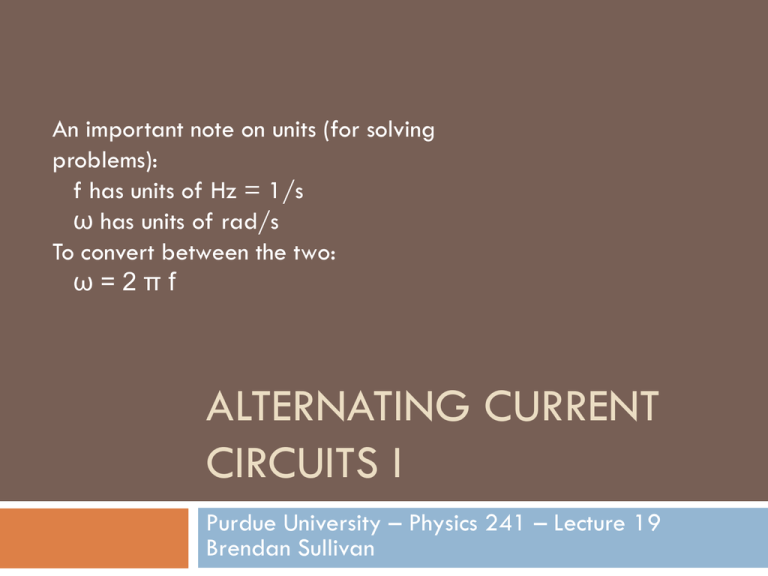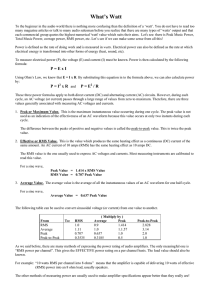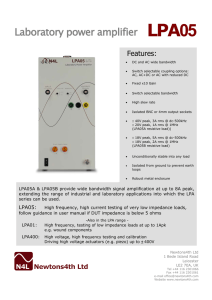Undriven alternating current cicruits
advertisement

An important note on units (for solving problems): f has units of Hz = 1/s ω has units of rad/s To convert between the two: ω=2πf ALTERNATING CURRENT CIRCUITS I Purdue University – Physics 241 – Lecture 19 Brendan Sullivan Overview Room Mean Square (rms) quantities Resistors in AC circuits Inductors in AC circuits Capacitors in AC circuits LC and RLC circuits Root Mean Square Values are a way to average periodic functions When talking about AC circuits we wish to discuss average quantities since instantaneous would be meaningless The average of a sine wave is zero, so we gain no information by analyzing its average To get the rms of any periodic function, average the square of the function, then take the square root 1.5 1 X rms 2 ( X ) avg 0.5 0 -0.5 0 -1 -1.5 1 2 3 4 5 6 7 RMS of Sine and Cosine Average sin2 over a whole period: 2 (sin ( ))avg 1 2 2 1 2 2 sin ( )d 0 2 1 [1 cos(2 )]d 2 0 1 2 To get the rms, we take the root of the average of the square (sin 2 ( ))avg (sin( ))rms 1 2 1 2 0.707 1.5 1 0.5 0 -0.5 -1 -1.5 0 1 2 3 4 5 6 7 Sine (blue) and sine squared (orange). Sine’s rms value is shown by the red line. RMS of a Sawtooth Function X max )t T Sawtooth wave: 0 We’ll get the average of X2: X (t ) ( T ( X (t )) 2 avg x T T 1 1 X max 2 X (t )dt ( t ) dt T0 T0 T 1 2 X max 3 Now, the rms is just the square root of that: X max ( X (t ) 2 ) avg ( X (t ))rms 3 X m ax X T T T T t X max 3 Quiz Question 1 In the United States, wall sockets are regulated at 120V rms at 60Hz. Determine the peak voltage out of a wall socket. a) 2V b) 42.4V c) 85V d) 120V e) 169V Alternating current generators are like batteries with sinusoidal voltage ac generator: spin a coil through a magnetic field at a constant frequency This induces a sinusoidal potential difference in time In circuits, we use these like a battery with a time varying voltage The flux (blue ~sine) through the loop and the induced current (orange ~cosine) Resistors in AC circuits -- + At all times, the potential difference across the resistor must be the same as that across the battery (for this circuit) For an AC generator, this means a sinusoidal voltage drop I(t) By Ohm’s Law, this means we must have (t ) I (t ) R VR (t ) a sinusoidal current I rms I peak That rms R peak R varies only by the constant R We can discuss both peak and rms values for current and voltage Finding the average power delivered by the generator Earlier in the semester, we found the power output by a battery. We add time dependence: P IV peak cos( t )) I peak peak cos2 ( t ) Now, we’ll take the average Pavg ( I peak cos( t ))( ( I peak 2 peak cos ( t ))avg I peak 2 peak I peak 2 peak 2 I rms rms So, the power is just the rms voltage times the rms current! You can verify that this is also the power dissipated in the resistor Inductors in AC circuits Loop Rule: dI L max cos( t ) dt 0 P Differential Equation Soln: I (t ) VL , peak L sin( t ) I peak sin( t ) With VL,peak=εmax (at some point, all voltage must be dropped across the inductor) For a driven inductor, voltage leads current by 90° (quarter cycle)! There is no net power delivered to this circuit (an inductive load): IV 1 ( I peak sin( t ))( max cos( t )) I peak 2 Pavg (sin( 2 t )) avg 0 max sin(2 t ) Inductive Reactance Let’s consider the rms current for an inductor/generator: I V L This looks almost like Ohm’s Law: I = V/R We can make this behave like Ohm’s Law if we define the reactance of an inductor: X L L , rms rms L I rms VL,rms L VL,rms XL Reactance is a frequency dependent, effective resistance for an inductor. It has units of Ohms (Ω) Quiz Question 2 An inductor of inductance 5mH is being driven at 200Hz (ω = 1257 rad/s). If the generator has an rms voltage of ε =12V, find the rms current. a) 1.3 A b) 1.9 A c) 2.7 A d) 8.5 A e) 12 A Capacitors in AC circuits Now, current leads voltage by a quarter of a cycle It was the opposite for an inductive load Again, the average power delivered by the circuit is zero We can easily relate the max(rms) current and charge: Loop Rule: max cos( t ) q(t ) C Solve for q(t): q(t ) VcC cos( t ) Q peak cos( t ) Use this to get current: I peak Q peak I rms Qrms I (t ) dq(t ) dt q peak sin( t ) 0 Capacitive Reactance Just as we defined an effective, frequency dependent resistance for inductors, we can do the same for capacitors Allows I peak us to nicely recover Ohm’s Law Qpeak XC CVC , peak VC , peak XC 1 C Like inductive reactance, capacitive reactance has units of Ohms! Undriven LC Circuits We start with a charged capacitor and no current. LC Oscillations 2 d Q dt 2 f0 1 Q LC 0 0 1 LC 0 2 The capacitor acts like a battery, so a current starts running. We went from zero current to some current, so an emf is induced in the inductor. The cycle repeats itself. UE Q2 , UB 2C 1 2 LI , I 2 dQ dt Undriven LC Circuits Loop Rule: dI L dt d 2Q L 2 dt Q C 0 Q C 0 This is the “mass on a spring” equation: Q (t ) I (t ) The circuit oscillates back and forth between charge stored on the capacitor and charge moving around the circuit It oscillates back and forth with a 1 natural frequency LC Qpeak t Q peak cos( t ) I peak sin( t ) 1 LC Ipeak Charge (blue) and current (orange) Energetics of an Undriven LC Circuit Energy stored in a capacitor: UC Q2 2C 2 Q peak cos 2 ( t ) Energy stored in an inductor: UL 1 2 LI 2 1 2 LI peak sin 2 ( t ) 2 U Q (t ) I (t ) Orange: Capacitor Energy Q peak cos( t ) Blue: Inductor Energy I peak sin( t ) Green: Sum (notice it’s constant) t Undriven RLC Circuit Now, we’ll add a resistor to the circuit Apply the loop rule: d 2Q dQ Q L R dt C 0 This is like the equation of motion for a damped mass on a spring dt 2 The resistance term acts as a damping force; it slowly drains energy from the system Large R: Energy is drained too quickly to oscillate Small R: Gradually diminishing oscillation Comparing (R)LC circuits to a harmonic oscillator Charge behaves like position (q,x) Current behaves like velocity (I=dq/dt, v = dx/dt) U Inductance behaves like mass (L,m) Capacitance behaves like inverse spring constant Energy stored in the capacitor is comparable to kinetic energy t Energy stored in the inductor is comparable to kinetic energy Quiz Question 3 Suppose we have an undriven RLC circuit oscillating at frequency ω0. We then double the capacitance. Determine the new frequency of oscillations, ω. a) ω = 4 ω0 b) ω = 2 ω0 c) ω = ω0 d) ω = ½ ω0 e) ω = ¼ ω0



